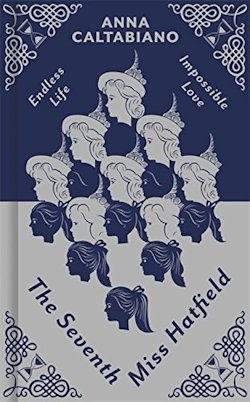The Seventh Miss Hatfield is seventeen year old Anna Caltabiano’s second novel: a scientific romance, after a fashion, and indeed, an extraordinary feat for someone so young. I can’t in good conscience recommend it, however—much as I might like to champion the work of such a promising new author.
It’s 1954, and Cynthia, a lonely little girl on the edge of adolescence, has become fascinated by her new neighbour: a strange lady who has spoken to no one in the weeks since she moved into the street. The better to get a glimpse of this antisocial character, Cynthia puts away her doll one day to take Miss Hatfield a package the postman abandoned when she refused to open her door. To her surprise and delight, she’s invited in for a glass of freshly made lemonade. Her host, however, slips some mysterious liquid into her drink: a drop of water from a lake discovered in the distant past by Ponce de Leon which immediately makes her immortal.
“I’m rescuing you from your life,” Rebecca Hatfield reasons. “I know you’re miserable. I’ve watched you playing with your doll. You don’t fit in with your friends or your family. You can’t fit in because you aren’t meant to—you’re meant for something greater than a normal existence.” Something more like the lot of a time-travelling identity thief, if you can believe it, as that’s exactly what Miss Hatfield asks Cynthia to do: to pop into the past, pretending to be someone else, so as to steal a prized painting.
But first, like all the best bad guys, Miss Hatfield outlines her origins. She, you see, is also immortal; eternally protected against “illness and death by natural causes” but not, alas, accidents. She too was once in the same situation in which Cynthia—the seventh such innocent to take the eponymous moniker—is suddenly stuck. This she explains to our perpetually uncertain protagonist:
“She told me that we become each other, since we were the only people we could trust. We need a life to turn to when we lose our own, and by taking on the name, we take on a history and another life.”
“So now… who am I?”
“You are me and I am you. We’re exceptions in time.”
And so, to New York in 1904, where Cynthia—or, rather, Rebecca—takes on yet another identity: that of Margaret, the bereaved Mr Beauford’s niece, and cousin to his understanding son Henley, all in service of pilfering a portrait of a lady that means a great deal to Miss Hatfield.
Henley, however, knows that Margaret isn’t who she says she is, but—sensing adventure, or something else—for the time being he keeps her secret. As the weeks wear on with no opportunity for our narrator to take the ancient painting, they grow closer, of course. Closer than cousins should, to be sure, and Margaret has been warned:
“We’re not like other people. We’re not made like them. You won’t even be able to physically tolerate staying in one period of time for long. Your body knows it’s not supposed to be here in this time. It’s uncomfortable. Unnatural, even. And you’re not only putting yourself in danger, but also me. Loving him will cost you my life as well as yours. It’s a selfish thing and you can’t afford to give in to it.”
But a love such as her and Henley’s… well. Love will find a way, won’t it?
On the sentence level, The Seventh Miss Hatfield does feature a few glimmers of brilliance, but these are few and far between, I’m afraid. By and large, Caltabiano’s prose is, at best, pedestrian. At worst, it’s simply insipid; rife with redundancy and incredibly heavy-handed. As an English teacher in real life, I wanted to do nothing so much as mark it.
Truth be told, I don’t want to bash this book—its author is obviously promising—but the bottom line is, it’s rarely more than mediocre. It reads like something self-published, which, wouldn’t you know, Caltabiano’s first novel, All That is Red, was. Its central character is a cipher; her behaviour—not least her unquestioning acceptance of her situation—frequently beggars belief; relatedly, the romance between her and Henley at the heart of The Seventh Miss Hatfield is hardly heartwarming.
In the interim, there are plot-holes aplenty, some alarming leaps of logic, and digressions that add nothing to the narrative—nor do they develop its characters, such as they are. The book’s setting—the city that never sleeps in the early twentieth century—is better, but it doesn’t get the attention it deserves. There’s potential in the premise as well. It brings to mind books like last year’s Life After Life. Alas, even the best bits of The Seventh Miss Hatfield can’t hold a candle to the least memorable moments of Kate Atkinson’s bittersweet period piece.
Clearly, The Seventh Miss Hatfield didn’t make a positive impression on me, but teens—fans of The Fault in Our Stars and so on—might well find it worthwhile… though I’d put that they, too, could do plenty better. Given how close certain elements of the text, in particular the premise and the setting, come to convincing, it’s entirely possible—probable, even—that Anna Caltabiano will be a talent of tomorrow, but I’m sorry to say she isn’t there today.
The Seventh Miss Hatfield is available July 31st from Gollancz (UK)
Niall Alexander is an extra-curricular English teacher who reads and writes about all things weird and wonderful for The Speculative Scotsman, Strange Horizons, and Tor.com. He’s been known to tweet, twoo.










